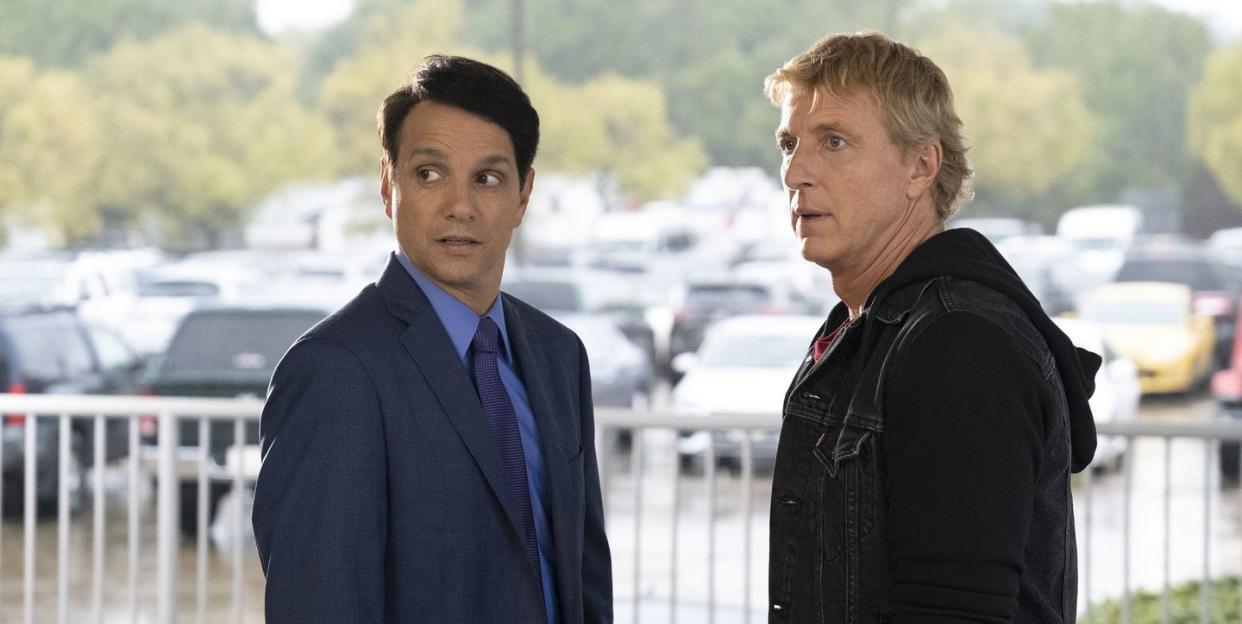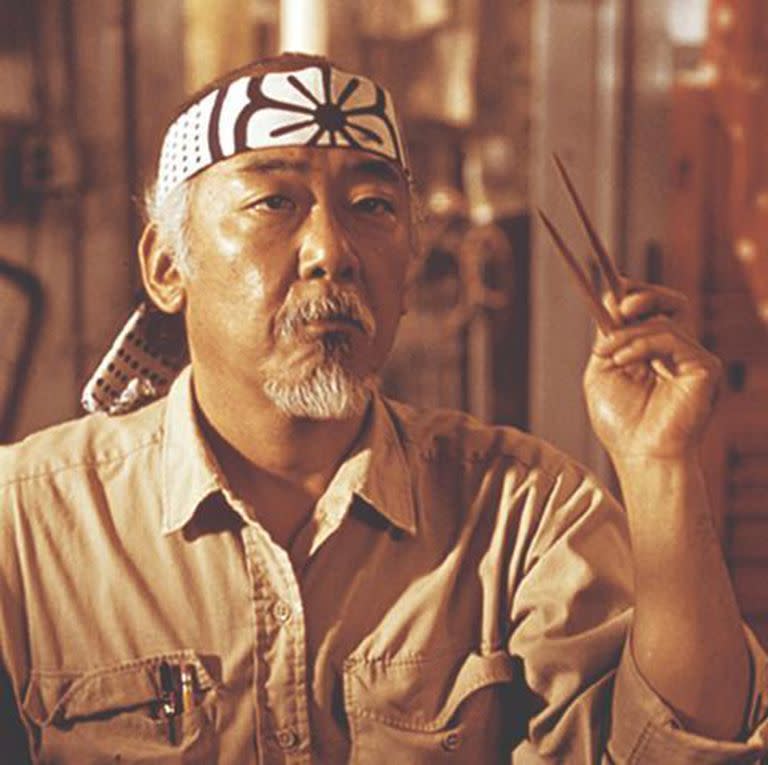'Cobra Kai' Needs to Make Some Big Changes When It Comes to Asian Representation

- Oops!Something went wrong.Please try again later.
The Karate Kid movie was a cultural touchstone. Who could forget "wax on, wax off," or the moment when Daniel LaRusso (Ralph Macchio) defeats Johnny Lawrence (William Zabka) in the All Valley Tournament? But underneath all that fun badassery, The Karate Kid offers something deeper and more valuable: a lesson on finding the strength to push through adversity and stereotypes.
It’s a classic underdog tale, made even better and rarer thanks to the Asian wisdom that's integrated into the movie. That's thanks in large part to Pat Morita’s wonderful and charming portrayal of the iconic Mr Miyagi, both an Okinawan karate sensei and an American veteran.

His role marked a big step for Asian representation on screen in the '80s, which was dominated — in Hollywood at least — by stereotypical and offensive Asian characters like the infamous Long Duk Dong from John Hughes’ Sixteen Candles.
Three decades later, the original story continues with YouTube Red's (now Netflix) original series Cobra Kai. The main core of the spinoff stems from the original movie, where the mind-body philosophy of Mr Miyagi is explored even deeper when Daniel reopens Miyagi-Do seconds after he realises that his nemesis Johnny is resurrecting the former’s rival dojo, Cobra Kai, in season one.
But where The Karate Kid is basically a coming-of-age story – and a very good one at that – the themes that Cobra Kai dives into are more complex, exploring the dichotomy of good and evil, redemption, and nature versus nurture.
Throughout its first three seasons, the show has mastered its storytelling approach while giving us plenty of nostalgic and kickass moments such as the one-take fight scenes at the end of seasons two and three.
Unfortunately, there’s still one thing that's lacking from the show, which is authentic Asian representation in the main story. In fact, Cobra Kai features almost no Asian characters at all, aside from Kyler (Joe Seo), the school bully, and Nathaniel (Nathaniel Oh), the kid who switches from Cobra Kai to Miyagi-Do.
Some may argue that this shouldn’t be a problem, especially considering how diverse the main cast is in general. Few shows are as diverse as Cobra Kai, but to not include integral Asian characters in a series that focuses on East Asian culture is disappointing at best and feels like a missed opportunity.

Imagine if Kyler had an arc where he learned to reconnect with his cultural identity through karate. If the writers wanted to avoid defining Kyler by his Asianness or Asian-Americanness alone, there are still plenty of ways to give him depth and expand his role from that of a one-dimensional bully – even when that’s already far from the usual stereotype faced by Asian actors.
But, of course, that’s not what happens here. Worse, he and some other POC characters like Aisha (Nichole Brown) – arguably the most interesting female character in the show – were sidelined in season two so that they could advance another white character, Tory (Peyton List), and reintroduce an old one, John Kreese (Martin Kove). Even Miguel (Xolo Maridueña), a member of the main cast, was written poorly in the sophomore season, reduced to just a cheesy love-triangle plot line.
Things, however, began to look a bit better at the beginning of the third season. It seems like the creators, Jon Hurwitz, Hayden Schlossberg and Josh Heald have started listening to these criticisms. Even Tamlyn Tomita made one ground rule before agreeing to reprise her role as Kumiko, Daniel’s paramour from the second original movie.
"I said I would love to, this would be so fun, but the only caveat is that because I’m older, because I’m a little bit more knowledgeable and I’m going to fight for it anyway — I need to be able to inject a truer picture of Okinawa," she told LA Times.
That’s, at least, what it looks like at the beginning. The reality is, of course, far from that. Aisha is written off. Kyler is reintroduced and has more screen time, but he's still portrayed one-dimensionally.
Even in the two episodes ('The Right Path' and 'Miyagi-Do') that take place in Okinawa, the show still fails to give us fleshed-out Asian culture and representation. Yes, we get a glimpse into traditional Okinawan dance in small detail. Also yes, Tomita’s portrayal of Kumiko and Yuji Okumoto's role as Chozen are both beautifully written. But aside from that, the show doesn’t really offer anything new. Kumiko and Chozen are still only there to advance the white character.
What's so disappointing about this is knowing what the show could have been like if it knew how to utilize its Okinawan setting a little better. Instead of delving deep into the origin of Miyagi-Do karate – what makes it different and special from the original Japanese karate – the show chooses to instead tie everything back to its favorite plot device: nostalgia.
Every moment between Daniel and Kumiko is only included so that the show can hark back to some of the sweetest moments from The Karate Kid Part II. As a result of this, we still don’t know much about Kumiko aside from the fact that she’s now teaching Okinawan traditional dance.
And we don’t know anything about Chozen outside of the new karate moves he shows to Daniel in episode five. We certainly do not know why and how Mr Miyagi acquired the wisdom he taught Daniel, or the reasons he hid some things from him.
Then instead of trying to recenter its POC characters, or flesh them out more, season three chooses to focus its story more on Kreese and Tory, which, even though done pretty well, shouldn’t have to take so much screen time throughout ten episodes. It’s a huge missed opportunity.
The sad truth about this problem is that it's not just an ongoing issue for this particular show, but it’s a bigger problem in Hollywood as a whole. Movies and TV shows — of course, including Cobra Kai itself — tend to treat diversity, and particularly in this case, Asian representation, as a quota.
As long as there’s one character who defies stereotypes or as long as there’s one or two episodes dedicated to the culture it wants to represent, they think that’s enough. But diversity and inclusion shouldn’t be a quota. Not back then, and definitely not right now, especially when Asian representation in Hollywood has slowly started to move forward with the arrival of shows like Kim’s Convenience and Fresh Off the Boat or groundbreaking movies such as Crazy Rich Asians.
If the original Karate Kid movies could create a complex Asian character in the form of Mr Miyagi while also including specific details about Asian culture and wisdom through his arc, then there’s no reason that Cobra Kai, in 2021, shouldn't be able to do the same.
The creators shouldn’t be afraid to course-correct things moving forward, and in fact, that is what they need to do if they want Cobra Kai to improve next season. It wouldn’t be considered cultural appropriation if the writers learned how to treat the culture and the people they want to represent with care and respect. Mr Miyagi and Pat Morita would certainly have been proud if Cobra Kai scaled up its representation game next season. Let’s hope the damage can still be undone.
You Might Also Like

